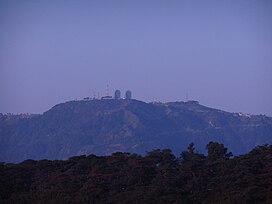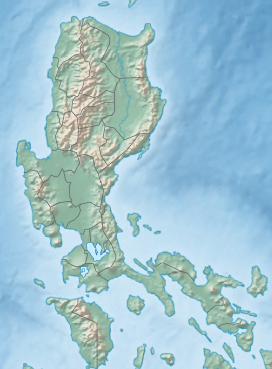| Mount Cabuyao | |
|---|---|
| Mount Kabuyao | |
 Mount Cabuyao with the landmark two satellite dishes on its summit | |
| Highest point | |
| Elevation | 2,025 m (6,644 ft)[1] |
| Prominence | 84 m (276 ft) |
| Coordinates | 16°21′23″N 120°33′32.8″E / 16.35639°N 120.559111°E |
| Geography | |
| Country | Philippines |
| Region | Cordillera Administrative Region |
| Province | Benguet |
| City/municipality | Tuba |
| Parent range | Cordillera Central |
| Climbing | |
| Easiest route | Hike |
Mount Cabuyao (alternatively spelled as Mount Kabuyao) is a mountain in the Philippines located in the municipality of Tuba in the province of Benguet. Its summit, rising to more than 2,000 metres (6,600 ft) above sea level,[1][2] overlooks the city of Baguio. It is commonly mistaken as Mount Santo Tomas, a taller mountain just beside it.[1]
Due to its high elevation, several communications companies constructed relay stations and radars at the summit.[3] A private observatory and AA radar station, once operated by the US Armed Forces stationed in the country, is also located here. A water catchment area was constructed to supply water to the City of Baguio and nearby towns. A small community of farmers live at the top of the mountain.[4] A town hall and a school was built for them by the local government.
Tourism
[edit]
Currently, no tourists are allowed to visit the mountain forest reserve because of the Permanent Environment Protection Order issued by the Court of Appeals on May 5, 2015.[5]
Previously, the two large satellite dishes at its summit have become a landmark for Baguio.[1][6] The summit is also a good vantage point. During fair weather, one can see the whole City of Baguio to the east and could partially see the province of Pangasinan to the west. On a clear day, one can observe moving cargo ships passing by the South China Sea.
Hikers climb the mountain occasionally for recreational purposes.[1] Biking is also popular.[2]
Forest cover
[edit]The mountain forest is part of the protected Mount Santo Tomas watershed, which supplies water to areas near the Ben Palispis Highway and other parts of Tuba.[7] In September 2014, the Supreme Court of the Philippines ordered the temporary ceasing of development projects in a disputed area covering the forest reserve.[8][9] [10] The affected area, which has been heavily deforested, was to be developed into an eco-tourism park, as planned by Baguio Representative Nicasio Aliping Jr.[7][8][9][10][11]
References
[edit]- ^ a b c d e "Mt. Cabuyao (2,025 +) / Mt. Sto. Tomas (2,256 +)". Pinoy Mountaineer. April 19, 2008. Retrieved September 30, 2014.
- ^ a b Tupaz, Voltaire (May 6, 2012). "Bikers race to raise funds for Cordillera forests". Rappler. Retrieved September 30, 2014.
- ^ "List of Field Stations, Northern Luzon PRSD". PAGASA. Archived from the original on October 6, 2014. Retrieved September 30, 2014.
- ^ "La Trinidad mayor wants more farmers to engage in strawberry production". DWDD (1134 kHz Metro Manila). March 5, 2014. Archived from the original on October 6, 2014. Retrieved October 1, 2014.
- ^ Agoot, Liza (March 13, 2019). "Task force tightens security at Benguet forest reserve". Archived from the original on March 17, 2019. Retrieved February 6, 2024.
- ^ "Mt. Cabuyao Troposcatter Dishes". Vista Pinas. July 11, 2010. Retrieved October 1, 2014.
- ^ a b Lacsamana, Hanna (June 1, 2014). "Mt Kabuyao diggings seen to defile springs". Baguio Midland Courier. Retrieved October 1, 2014.
- ^ a b Aning, Jerome (September 30, 2014). "SC stops activities in Mt. Santo Tomas forest". Philippine Daily Inquirer. Retrieved October 1, 2014.
- ^ a b Merueñas, Mark (September 30, 2014). "SC stops road project in Benguet for now". GMA News. Retrieved October 1, 2014.
- ^ a b "Seeing The Damage Done In Cabuyao/Sto. Tomas Is Shocking: And That's Putting It Mildly". Cordillera Sun. July 16, 2014. Retrieved October 1, 2014.
- ^ Fontanilla, Giovani Joy (August 31, 2014). "Chronicling Kabuyao's destruction". Sun.Star Baguio. Retrieved October 1, 2014.
External links
[edit] Media related to Mount Cabuyao at Wikimedia Commons
Media related to Mount Cabuyao at Wikimedia Commons

